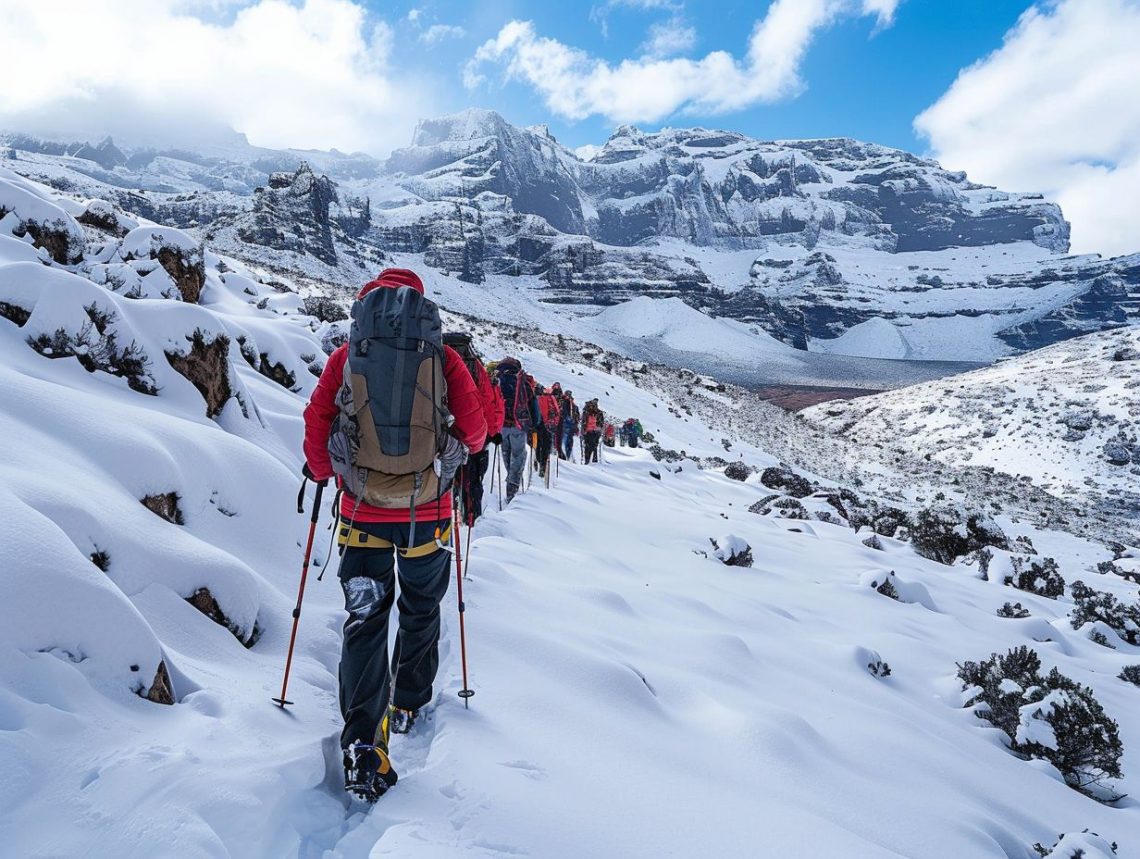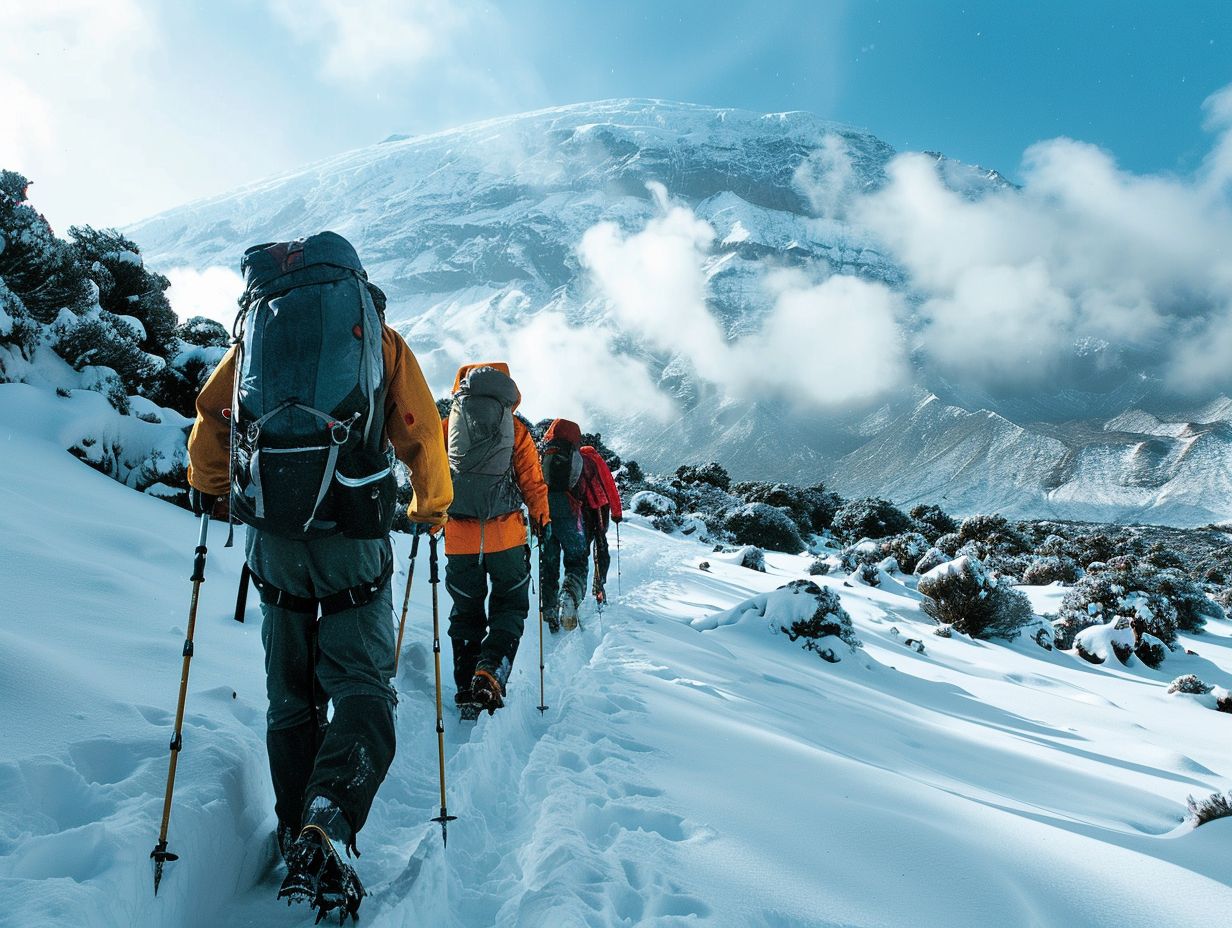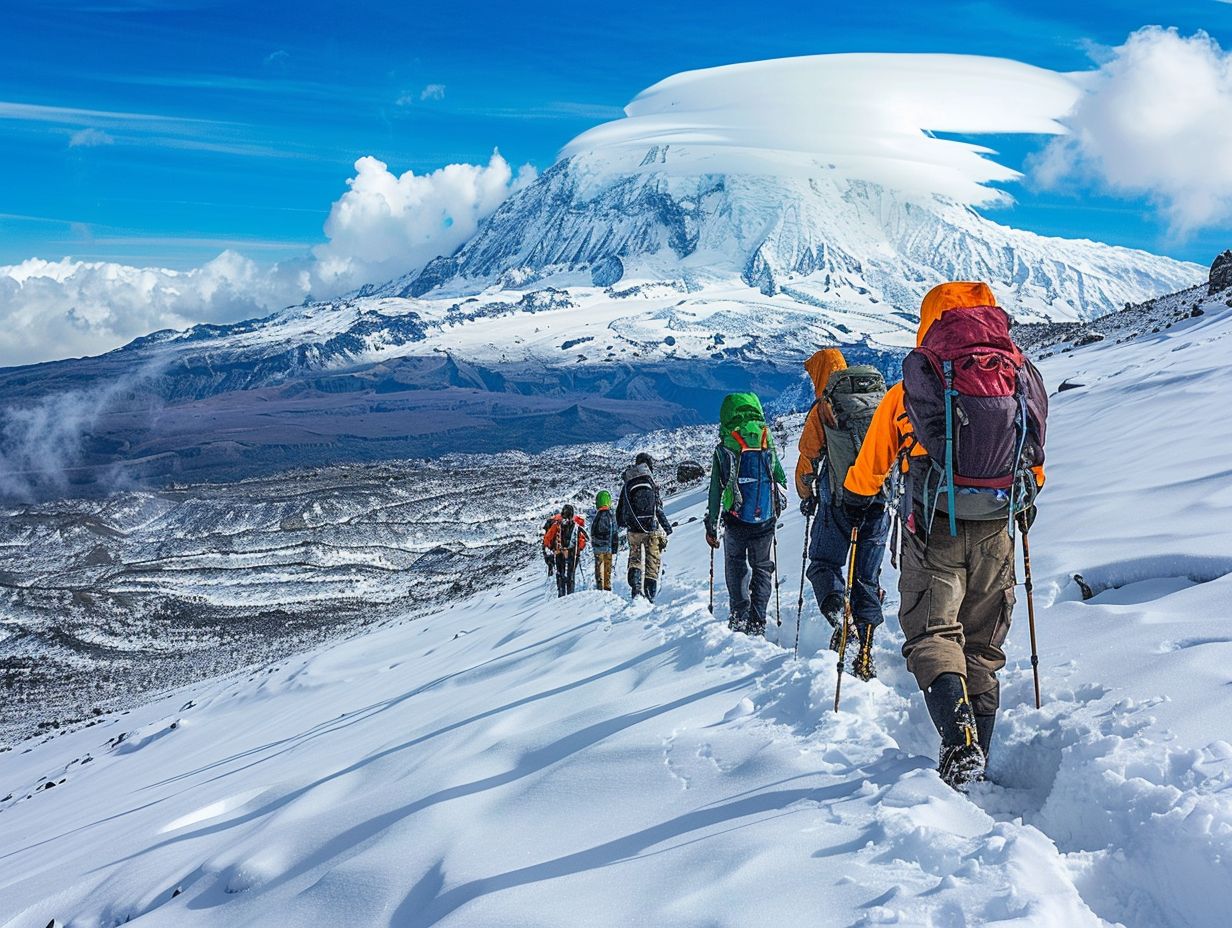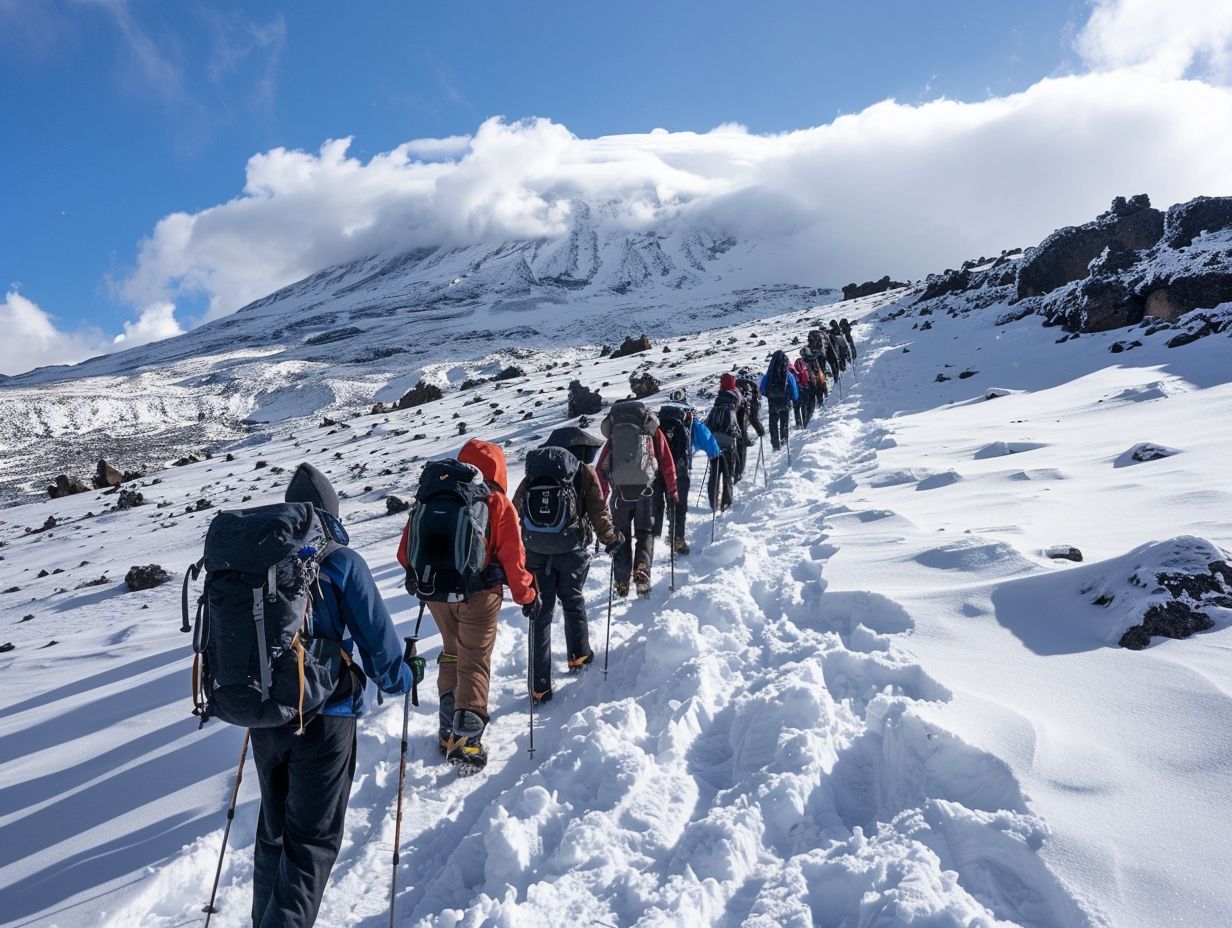
The Beginners Guide To Climbing Kilimanjaro
Have you ever dreamed of standing on the roof of Africa? Climbing Kilimanjaro is a bucket list adventure for many outdoor enthusiasts.
In this comprehensive guide, we will explore everything you need to know before embarking on this epic journey.
From the different routes to the best time to climb, physical requirements, gear essentials, challenges, and preparation tips, we’ve got you covered.
So lace up your hiking boots and get ready to conquer Africa’s highest peak!
Key Takeaways:

- Climbing Kilimanjaro is a challenging but rewarding experience that involves reaching the highest peak in Africa.
- People climb Kilimanjaro for various reasons, such as personal achievement, adventure, and to experience the beauty of the mountain and its surroundings.
- Kilimanjaro has multiple routes to choose from, each with its own level of difficulty and scenery, so it’s important to research and pick the best one for your abilities and preferences.
Why do People Climb Kilimanjaro?
People climb Kilimanjaro for various reasons, including seeking the thrill of conquering its challenging terrain, experiencing the breathtaking views from the summit, and achieving personal goals of success and perseverance.
Mount Kilimanjaro draws climbers from around the globe to test their physical and mental endurance. The allure of this majestic mountain lies it’s impressive height and in the sense of adventure it offers.
For many, the journey to the top represents more than just a physical feat; it embodies personal growth, pushing boundaries, and embracing the unknown.
It’s this combination of challenge, beauty, and self-discovery that keeps adventurers coming back, seeking that ultimate sense of accomplishment that awaits at the peak of Kilimanjaro.
What are the Different Routes to Climb Kilimanjaro?
There are several routes to climb Kilimanjaro, each offering a unique experience and varying levels of difficulty. The popular routes include Marangu, Machame, Lemosho, Rongai, Northern Circuit, Umbwe, and Shira.
1. Marangu Route
The Marangu Route, often referred to as the ‘Coca-Cola’ route, is the oldest established route on Kilimanjaro and is popular among climbers for its relatively easier trekking paths and accommodation in mountain huts.
Established in the early 1900s, the Marangu Route holds historical significance as it was the first official route recognized for climbers to summit Kilimanjaro.
The experience of climbing this route offers a blend of lush forests, stunning vistas, and diverse ecosystems, providing climbers with a memorable journey to the ‘Roof of Africa’.
One unique feature of the Marangu Route is the presence of mountain huts along the trail. These huts provide shelter and basic amenities, making it a preferred choice for those seeking a more comfortable ascent.
The availability of bunk beds and dining facilities in the huts offers climbers a convenient accommodation option compared to camping.
2. Machame Route
The Machame Route, known as the ‘Whiskey’ route, is one of the most challenging paths to the summit of Kilimanjaro, favored by climbers seeking a more demanding and scenic trekking experience.
The trail offers a variety of landscapes, from dense rainforests to alpine deserts, providing a diversity of views along the way. Climbers are drawn to the route’s steep ascents, testing both physical and mental stamina.
The camping arrangements on the Machame Route are well-organized, with designated sites set up at strategic points, allowing climbers to rest, refuel, and bond with fellow adventurers after a day of strenuous hiking.
2. Lemosho Route
The Lemosho Route is renowned for its scenic beauty and remote wilderness, offering climbers a diverse and awe-inspiring trekking experience while allowing for effective acclimatization to the altitude.
One of the standout features of the Lemosho Route is the stunning panorama of landscapes it presents, from lush rainforests to alpine meadows, all the way to the challenging barren terrain closer to the summit of Kilimanjaro.
This diverse terrain not only adds to the visual appeal of the trek but also aids in climbers’ acclimatization, as they gradually ascend through different altitude zones, reducing the risk of altitude sickness.
3. Rongai Route

The Rongai Route, located on the northern side of Kilimanjaro, is a quieter and less-traveled path, offering climbers a sense of remoteness and tranquility during their ascent, making it a relatively easier option for beginners.
One of the distinctive features of the Rongai Route is its peaceful ambiance, away from the busier trails found on the southern slopes of Kilimanjaro. The route’s remote location provides a serene escape for climbers.
The Rongai Route is particularly suitable for less-experienced climbers, as it offers a gradual and less steep ascent compared to other routes. This gentler gradient allows climbers to acclimatize more effectively.
3. Northern Circuit Route
The Northern Circuit Route is the longest path to the summit of Kilimanjaro, offering climbers a scenic and immersive journey through the mountain’s diverse landscapes.
Spanning approximately 97 kilometers, climbers are treated to panoramic views of breathtaking glaciers, dense forests, and rolling moorlands that truly showcase the beauty of Kilimanjaro.
One of the key advantages of the Northern Circuit Route is the emphasis it places on acclimatization, allowing climbers to adjust gradually to the altitude and reducing the risk of altitude sickness.
This factor significantly enhances climbers’ chances of successfully reaching the summit.
What is the Best Time to Climb Kilimanjaro?
The best time to climb Kilimanjaro is during the dry seasons, from late June to October, and from December to February. These periods offer favorable weather conditions with less precipitation.
During these dry seasons, climbers can enjoy clear skies, breathtaking views, and drier trails. With lower chances of encountering heavy rains, the ascent becomes more manageable, ensuring a safer and more enjoyable journey.
Proper preparation is crucial, regardless of the chosen dry season, as the altitude and unpredictable weather patterns demand meticulous planning.
Ensuring you have the right gear, hiring experienced guides, and acclimatizing properly are key factors in increasing your chances of a successful climb.
What are the Physical Requirements for Climbing Kilimanjaro?
Climbing Kilimanjaro requires a good level of fitness, endurance, and mental resilience to overcome the physical challenges of high altitude and long trekking days.
At Mount Kilimanjaro, altitude can soar up to 19,341 feet, resulting in reduced oxygen levels and potential altitude sickness. Climbers must train diligently beforehand, emphasizing cardiovascular fitness and strength.
The steep inclines and rocky terrain demand leg strength and stability. Mental preparedness is equally vital, as the trek can be mentally exhausting due to its duration and unpredictable weather conditions.
What are the Essential Gear and Equipment for Climbing Kilimanjaro?
When climbing Kilimanjaro, having the right gear and equipment is essential for a safe and successful journey. Items such as proper clothing, sturdy footwear, trekking poles, and camping gear are crucial.
Proper clothing for Kilimanjaro should include moisture-wicking base layers, insulating mid-layers, a waterproof jacket, and gloves to combat the varying weather conditions.
Layering is key to staying warm and comfortable throughout the ascent. Investing in high-quality hiking boots with good ankle support is vital to navigate the rocky terrain.
Trekking poles provide stability and reduce strain on your knees during steep sections. Camping essentials like a durable tent, sleeping bag rated for low temperatures, and a reliable headlamp are essential for overnight stays.
What are the Common Challenges and Dangers of Climbing Kilimanjaro?
Climbing Kilimanjaro presents various challenges and dangers, including high altitude sickness, unpredictable weather conditions, physical exhaustion, and the risk of injury.
One of the key difficulties climbers face on Kilimanjaro is the rapid change in altitude. As the ascent progresses, the air becomes thinner, leading to altitude sickness symptoms like headaches, nausea, and fatigue.
The mountain’s weather can shift unexpectedly, from scorching sun to freezing temperatures, posing a threat to climbers’ well-being.
The physical strain of navigating steep terrain and enduring long hikes can also take a toll on even the fittest adventurers.
How to Prepare for Climbing Kilimanjaro?
Effective preparation is key to a successful Kilimanjaro climb, involving physical training, acclimatization routines, mental readiness, and familiarity with the terrain.
A well-rounded approach to preparation enhances climbers’ chances of reaching the summit.
1. Physical Training

Physical training for Kilimanjaro should focus on building endurance, cardiovascular fitness, and leg strength to withstand long trekking days and high altitudes.
Regular exercise routines tailored to climbing preparation are essential for climbers’ success. To enhance endurance, climbers should engage in activities like hiking, running, or cycling to build stamina.
Integrate high-intensity interval training (HIIT) sessions to boost cardiovascular fitness. Strength training, particularly focusing on legs and core, is crucial for stability during climbs.
Incorporating uphill walks and stair climbing mimics the terrain of Kilimanjaro. Developing a balanced regimen that includes flexibility and balance exercises can prevent injuries and improve overall performance.
Consultation with a fitness trainer or experienced climber can help in creating a personalized training plan to achieve climbing goals.
2. Acclimatization
Proper acclimatization on Kilimanjaro involves a gradual ascent to higher altitudes, allowing the body to adjust to reduced oxygen levels and prevent altitude sickness.
One crucial strategy for acclimatization is the ‘climb high, sleep low’ approach, where climbers ascend to higher altitudes during the day but descend to lower camps for a better night’s rest.
This technique helps the body adjust gradually without overexertion. Maintaining proper hydration is essential, as dehydration can exacerbate altitude-related issues.
It is recommended to drink plenty of water throughout the climb and consume electrolyte-rich fluids to support the body’s adaptation.
Recognizing the symptoms of altitude sickness, such as headaches, nausea, and fatigue, is crucial for early intervention. Climbers should be aware of their own physical condition and communicate any discomfort to their guides.
To acclimatize effectively, it is advisable to plan rest days at certain altitudes to allow the body time to adjust. Prior physical fitness and a slow, steady pace during the ascent can also aid in successful acclimatization.
3. Mental Preparation
Mental preparation for Kilimanjaro involves developing resilience, positive mindset, and motivation to overcome challenges, fatigue, and uncertainties during the climb.
Climbers must cultivate a resilient attitude to adapt to changing conditions, such as weather variations and physical exhaustion. Having a robust mental framework can help manage stress and anxiety.
Maintaining motivation is key, as it serves as a driving force when facing steep inclines and high altitudes. A positive mindset enhances overall well-being and also facilitates a smoother climb.
What is the Cost of Climbing Kilimanjaro?
The cost of climbing Kilimanjaro varies depending on factors such as the chosen route, tour operator, duration of the expedition, and included amenities.
When planning the financial aspects of your Kilimanjaro journey, it’s crucial to consider the permit fees, which can range from $50 to $1000 depending on the route and season.
Hiring experienced guides is highly recommended for safety and can cost between $20 and $30 per day. Equipment is another significant expense, with gear rental generally around $50-$100.
Accommodation and meals during the trek add to the overall cost, typically varying between $1000 to $4000 for the entire expedition.
Thorough budgeting and research can help climbers make informed choices and enjoy a successful ascent.
What are the Accommodation Options for Climbing Kilimanjaro?
Accommodation options for climbing Kilimanjaro range from camping in tents at designated campsites to staying in mountain huts along certain routes.
In terms of camping, climbers have the freedom to select their camping spots, enjoy the tranquility of nature, and immerse themselves fully in the wilderness experience.
On the other hand, mountain huts offer a more structured and secure lodging option, providing basic amenities and a refuge from the elements.
While camping allows climbers to feel closer to nature and experience the ultimate outdoor adventure, staying in huts can offer a more comfortable and sheltered environment, especially during harsh weather conditions.
Each accommodation choice comes with its own set of advantages and considerations, catering to the diverse preferences and needs of Kilimanjaro climbers.
What is the Summit Day Like on Kilimanjaro?
Summit day on Kilimanjaro is the ultimate challenge for climbers, involving an early morning start, a strenuous trek to Uhuru Peak, the highest point, and a moment of celebration and achievement upon reaching the summit.
The ascent to Uhuru Peak is not only a test of physical endurance but also a mental battle against the changing altitude and unpredictable weather conditions.
The sheer determination required to push through fatigue and overcome obstacles along the way is what sets this experience apart.
When the first rays of sunlight touch the summit, casting a golden hue over the snow-capped peak, it is a breathtaking moment that makes all the challenges seem worthwhile.
What Happens After Reaching the Summit of Kilimanjaro?

After reaching the summit of Kilimanjaro and celebrating the achievement at Uhuru Peak, climbers begin their descent back to lower altitudes. Upon completion, climbers receive certificates of ascent as mementos.
As climbers descend from the peak, they are welcomed by the breathtaking views of the mountain’s slopes and surrounding landscapes, offering a different perspective of their journey.
The distribution of ascent certificates serves as a tangible token of their determination and hard work, a testament to their resilience in conquering the tallest peak in Africa.
Reflecting upon the challenges faced during the climb, climbers share stories and experiences, forging bonds that extend beyond the mountain.
The celebratory atmosphere is palpable as climbers gather to commemorate their collective achievement, a moment etched in their minds as they bid farewell to Kilimanjaro.
Frequently Asked Questions
1. What is Kilimanjaro and why should I climb it as a beginner?
A: Kilimanjaro is the tallest mountain in Africa and is a popular destination for beginner climbers due to its relatively easy hiking trails and stunning views.
2. Do I need prior experience to climb Kilimanjaro?
A: While prior hiking and trekking experience can be helpful, it is not necessary to have any technical climbing skills to successfully reach the summit of Kilimanjaro. However, it is important to be physically fit and mentally prepared for the physically demanding journey.
3. What is the best time of year to climb Kilimanjaro?
A: The best time to climb Kilimanjaro is during the dry season, which runs from late June to October. This is when the weather is most stable and the chances of rain and snow are lower, making it easier and safer to climb.
4. How long does it take to climb Kilimanjaro?
A: The average length of a Kilimanjaro climb is 7-8 days, with most routes ranging from 6-9 days. It is important to choose a route and itinerary that allows for proper acclimatization to help prevent altitude sickness.
5. What should I pack for a Kilimanjaro climb?
A: Some essential items to pack for a Kilimanjaro climb include proper hiking boots, warm clothing for cold temperatures at high altitudes, a waterproof jacket, a good quality sleeping bag, and a headlamp for early morning hikes. It is also important to pack enough snacks and water to stay hydrated and energized throughout the climb.
6. Do I need a guide or can I climb Kilimanjaro on my own?
A: It is required to have a guide for all Kilimanjaro climbs. This is for your safety as well as for supporting the local economy and preserving the mountain’s environment. It is recommended to book through a reputable tour company that provides experienced guides and proper equipment for the climb.